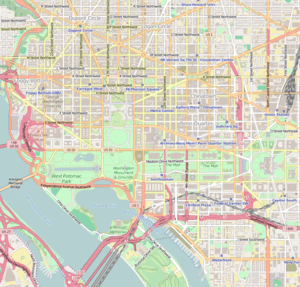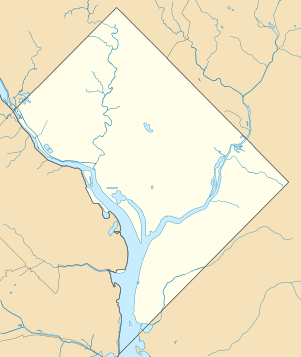Lisner Auditorium
|
| |
| Address |
730 21st St, NW Washington, D.C. United States |
|---|---|
| Public transit |
Washington Metro |
| Owner | George Washington University |
| Capacity | 1,490 |
| Construction | |
| Opened | 1943 |
| Architect | Faulkner and Kingsbury |
| Website | |
|
Lisner Auditorium | |
   | |
| Coordinates | 38°53′57.57″N 77°2′49.13″W / 38.8993250°N 77.0469806°WCoordinates: 38°53′57.57″N 77°2′49.13″W / 38.8993250°N 77.0469806°W |
| NRHP reference # | 90001548[1] |
| Designated | October 25, 1990 |
Lisner Auditorium is an auditorium located on the campus of The George Washington University, at 730 21st Street, Northwest, Washington, D.C.. It is named for Abram Lisner, a trustee of the University who donated the money for its construction.
Constructed in 1943, it served as the focus of theatrical life in Washington prior to the opening of the Kennedy Center. Today, it is still used for performances, and is the home of several companies including Washington Concert Opera.
The auditorium seats 1,490 people.[2]
The auditorium was added to the National Register of Historic Places in 1990.
Art
Outside of the Auditorium is the River Horse sculpture. In 1996 George Washington University President Stephen Joel Trachtenberg presented this bronze statue of a hippopotamus as a gift to the University's Class of 2000. The auditorium contains a mural by Augustus Vincent Track, and the Dimock gallery is located on the lower Lisner Lounge.
History
Construction
Construction of Lisner Auditorium was initially funded by Abram Lisner, a German-born owner of Washington's Palais Royale department store.[3] Additional funding for the construction project was provided by the George Washington Memorial Association and the Dimock Estate.
The building was designed by Faulkner and Kingsbury and built by Charles H. Tompkins Company. Work commenced on the Auditorium in 1941; it was completed in 1943.
Desegregation controversy
On October 9, 1946 the theater declined entry to African-Americans, including the Dean of the Howard University Medical School. A leaflet and boycotting campaign ensued. The National Symphony Orchestra canceled performances.[4] In 1947, the Board of Trustees changed policy to admit African-Americans to sponsored events, but did not completely desegregate until 1954.
References
- ↑ National Park Service (2009-03-13). "National Register Information System". National Register of Historic Places. National Park Service.
- ↑ "Lisner Auditorium Seating Chart" (PDF).
- ↑ "Lisner Auditorium". The GW and Foggy Bottom Historical Encyclopedia. Archived from the original on 2010-06-13.
- ↑ "Lisner Auditorium segregation controversy, 1946". The GW and Foggy Bottom Historical Encyclopedia.
External links
- Official Lisner Auditorium website
- Box Office website
- Lisner Auditorium entry at The George Washington University and Foggy Bottom Historical Encyclopedia
- "Energy secretary talks sustainability at Lisner Auditorium", GW Hatchet, Priya Anand, October 7, 2010
| Wikimedia Commons has media related to Lisner Auditorium. |
